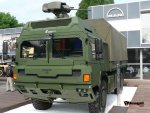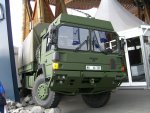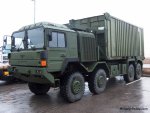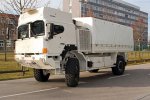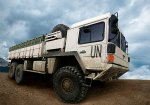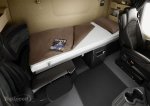egn,
Well, finally finished two extended series on the Rheinmetall-MAN HX/SX series of trucks, the first of which I called a “Photo-Essay”, and the second a “Gallery”. They are on pages 25, 26, 27, and 28 of the thread, beginning at the bottom of page 25 at
http://www.expeditionportal.com/for...pedition-RV-w-Rigid-Torsion-Free-Frame/page25 .
I wrote those pages mainly because many people in North America do not seem to know what a MAN-KAT actually is, and they seem to know even less about the Rheinmetall-MAN HX and SX series. If one is German, then one grows up seeing MAN-KATs driving on roads. And given that most German men served in the military for 6 - 10 months when they were young, most German men will have seen them there. But in North America MAN-KATs are virtually non-existent, so when Americans imagine what they must be like, many immediately think of an 8x8 missile carrier. It then seemed important to do a write-up and gallery, explaining the truck series for some of the younger or less experienced participants on ExPo.
Now if you have the time, and if you are interested, it would be great if you could answer some of the questions that emerged as in the course of writing those pages. The following provides a summary of those questions:
********************************
HX, SX, and MAN-KAT QUESTIONS
*********************************
1. The British currently have over 7,000 RMMV (Rheinmetall-MAN) vehicles in service, most of which are HX trucks. About 600 of those trucks are HX-58, and fewer than 200 are SX-44. I am not sure how many SX-45 trucks the British purchased (mostly as recovery vehicles), but it’s probably a low number. If you know the number of for British SX-45s in service, that would be great. But I am more interested in what the German numbers might be.
So, how many HX and SX vehicles would you estimate are in service in Germany right now, with the German Army and Air-Force? And how many older MAN-KATs are still in service? Apparently, MAN sold over 14,000 MAN-KAT trucks to the German armed forces up to 1984, and thousands more were exported abroad – see
http://www.military-today.com/trucks/man_kat1_8x8.htm . But that was 30 years ago, and who know how many thousands more have been sold since then?
Furthermore, I get the impression that the
GTF – the
Geshützte Transportfahrzeuge program – moves very slowly, and that old MAN-KATs are just as likely to be replaced by new Actros or Zetros trucks, as they are to be replaced by HX or SX series trucks. Is this true?
Out of the German Army and Air-Force totals, how many trucks would you estimate are truly SX-series? And within that number, how many would you estimate are SX-45, and how many SX-44? And finally, how many of the “top-tier” MAN-KAT A1s are still used by the German armed forces, i.e. the MAN-KATs of the most advanced kind, that were in production before the name changed to “SX”, with the third-generation series of “gl” trucks?
Has Germany also been purchasing thousands of HX-series trucks, like Britain?
Don’t worry, I am not looking for exact figures here, just very rough, rounded, “ball-park” sort of numbers. You are a key member of the MAN-KAT community in Germany, so I figured that if anyone might know some of these figures off the top of his head, it might be you....
 *********************************
2.
*********************************
2. In the United States, only 12 HEMTTs are registered for civilian use – see the “
Hemtt Define America Project” thread, at
http://www.expeditionportal.com/forum/threads/48137-Hemtt-Define-America-Project/page3 :
Currently there are about 12 HEMMT that are tagged and certified for civilian use.
Whereas there seem to be many, many more second-hand, used MAN-KATs repurposed for civilian use driving on European roads.
How many civilian MAN-KATs would you estimate are currently on the road in Germany? And in Europe as a whole?
*********************************
3. On page 26 I wrote that it might be very difficult to find a second-hand, ex-military SX-series truck in Germany – see or
http://www.expeditionportal.com/for...pedition-RV-w-Rigid-Torsion-Free-Frame/page26 :
I tried researching comparative deployment in Germany versus the UK, but came up short. The only "hard" number for the German armed forces that I found was 14,000, which is the total number of MAN-KATs that were delivered up to 1984, or 30 years ago -- see
http://www.military-today.com/trucks/man_kat1_8x8.htm . Of course thousands of MAN-KATs have also been exported. But I could not find a total figure for the number of MAN-KATs still in service in Germany today, or the comparative number of newer SX and HX trucks. Furthermore, my impression is that Germany’s “
GTF” procurement program is very slow-moving, and that aging Bundeswehr MAN-KATs have not necessarily been replaced by HX or SX trucks, but rather, as often as not by Zetros or Actros trucks. Again, see
http://translate.google.co.uk/trans...jFf_K7rTcHdV7XVXNUJwzzvP8BsADx5A!!/&sandbox=1 . And even if the Bundeswehr were not replacing MAN-KATs with Actros and Zetros trucks, the German government probably wants to replace aging MAN-KATs as slowly as possible, in order to save money.
If all of this is true, then it seems quite possible that one might sooner find a used HX or SX truck in the UK, as opposed to Germany. At present (May 2014), no ex-military HX or SX trucks are for sale by Aigner, FTN, or Mobile.de. Instead, just the usual assortment of MAN-KATs – see
http://www.aignertrucks.com/en/vehicles/current-stock ,
http://www.inter-commerz.com/index.php/en/katalog-3 ,
http://suchen.mobile.de/lkw-inserat/man-kat-8x8-ladekran-perfekter-zustand-freiburg/194619517.html ,
http://suchen.mobile.de/lkw-inserat/man-kat1-mil-5t-glw-4x4-pritsche-winde-h-zul-fähig-potsdam/182488836.html , and
http://suchen.mobile.de/lkw-inserat/man-man-kat1-a1-dfaeg-6x6-militärtruck-geländegig-hennef/36400632.html . But again, I am not certain whether this is an accurate description of that state of HX and SX procurement in Germany, and
egn would be in a much better position to make such an assessment.
Is this true? As near as I can tell, none of the big German second-hand resellers currently carry SX models. Instead, they only seem to have older MAN-KAT vehicles.
Do you think it would be easy, or hard, to find a used SX-44 or SX-45 on the second-hand market in Germany?
*********************************
4. Which do you think would be better: a Tatra T-815 6x6, or a Rheinmetall-MAN SX-44 6x6? And why?
Please see the brief list of pros and cons at the bottom of page 26, and the discussion that followed – see
http://www.expeditionportal.com/for...pedition-RV-w-Rigid-Torsion-Free-Frame/page26:
So which would be better, a MAN SX-44 (if one can find one...), or a Tatra 815 6x6, either commercial or ex-military, of the sort that Jago Pickering used for his expedition motorhome? On the plus side:
•
....a used Tatra Phoenix or T 815 6x6 chassis would probably be easier to find than an SX-44 chassis
•
....a Tatra chassis would probably cost much less than a comparable SX chassis, whether built new, or found used
•
....a Tatra chassis would be even stiffer and more torsion-free than an SX-44 or SX-45 chassis
But on the downside:
•
....Tatra is a small company in comparison to MAN, and Tatra's service network is not nearly as large
•
....Tatra's ownership has changed a number of times over the last two decades, and Tatra's future always seems somewhat in doubt – see for instance
http://www.opinicus-sro.com/Tatra-et-son-futur-en-point-d
•
....The Tatra 815's central tube-frame might be heavier than a comparable MAN SX-44
•
....The Tatra's 815's fuel consumption might be comparatively high
The last two "downsides" were suggested by
egn, again in his thread about
Blue Thunder.
Are you certain that the weight of a new Tatra T-815 military-grade truck would be more than the weight of a comparable SX-series truck? Remember, earlier in the thread I posted something about the weight of a commercial Tatra Phoenix 6x6 truck, and it did not seem to weigh more than a comparable Zetros 6x6.
Are you also certain that a Tatra’s fuel consumption would be much worse than an SX-series truck, especially now that Tatras can be fitted with lots of different engines, from different manufacturers? Again, see
http://www.tatratrucks.com/why-tatra/tatra-vehicle-design/tatra-engine/ ,
http://en.wikipedia.org/wiki/Tatra_815 ,
http://www.tatratrucks.com/trucks/product-catalog/t-815-7/ ,
http://www.tatratrucks.com/trucks/c...-trucks/6x6-high-mobility-heavy-duty-chassis/ ,
http://www.tatratrucks.com/underwood/download/files/tatra-t815-790rk9-6x6-chassis_en.pdf ,
http://www.tatratrucks.com/trucks/c...-trucks/8x8-high-mobility-heavy-duty-chassis/ ,
http://www.tatratrucks.com/trucks/c...ity-heavy-duty-universal-cargo-troop-carrier/ ,
http://www.tatratrucks.com/trucks/c...ility-heavy-duty-universal-container-carrier/ ,
http://www.tatratrucks.com/underwood/download/files/tatra-military-vehicles_en-2.pdf ,
http://www.military-today.com/trucks/tatra_t815_78or89.htm , and
http://www.military-today.com/trucks/tatra_t815_7mor89.htm .
*********************************
5. Deutz no longer seems to make a V8 air-cooled engine for specifically automotive use – see
http://www.deutz.com/live_deutz_pro...xVGWBFRLggTTx7mZ9AUjDDd-wnO3LwAsA2rMs7yaJ-i_H . Sure, Deutz still makes air-cooled engines for mobile machinery, for generators, for agricultural machinery, and for marine applications. But it seems that the most powerful Deutz air-cooled engines, the 413 FW series, are now sold only as underground mining engines – see
http://www.deutz.com/live_deutz_products/file/8a85818a11c1035d0111e008b88a026d.de.0/413fwuen.pdf . I tried looking for new, current information about Deutz V8 air-cooled automotive engines, and could find nothing.
So is this true? Does Deutz no longer make large, V8, air-cooled engines for RMMV trucks, or for any trucks?
What do you think about Tatra’s air-cooled V8 engine? Again, see
http://www.tatratrucks.com/why-tatra/tatra-vehicle-design/tatra-engine/ . If Deutz no longer makes an air-cooled automotive V8, then perhaps Tatra is now alone, the only remaining producer of such engines? Apparently, Tatra’s air-cooled V8 can be made Euro-5 compliant.
Do you think an air-cooled engine is still strongly preferred?
Blue Thunder has an air-cooled Deutz, so you seem to be in favor. But of course what was feasible 10 years ago may not be feasible today, because of tightening emissions restrictions.
So given a choice today, would you go with a liquid-cooled MAN, Cummins, Caterpillar, or Deutz engine instead? Or would you still want an air-cooled Tatra? Or perhaps an air-cooled Deutz engine driving a generator in an electric-hybrid vehicle?
*********************************
6. Tatra seems willing to sell to whomever it can, and one imagines that Tatra would also be willing to sell a new, military-specification T-815-7 to a civilian customer. Do you think RMMV (Rheinmetall-MAN) would be willing to do the same? Or are there laws in Germany that would prevent this?
As
109 Pretender wrote in the “
Hemtt Define America Project” thread, in the United States there are indeed laws that would prevent this. In the United States the laws that would prevent this are so stringent, that they even seem to have undermined the very possibility of a robust American second-hand market for used, ex-military vehicles:
Asdean,
….Here's another reason I have my doubts that the HEMTT can't and never will be certified by DOT for civilian use. All excess military vehicles like this have to be 'de-militarized' before being sold for presumably scrap metal or military collectibles to the public. Meaning they get cut up with a torch. As a matter of fact there are only around 80 street legal military HUMVEE's from the 1980's depot sale in I think Atlanta. After that sale, the DOT stated that a military HUMVEE was not capable of meeting existent safety laws. All HUMVEE's that are sold today in public government. auctions have to be cut in half before being allowed to leave the depot. (Not that several haven't been purchased and welded back together - because some have...) But, they aren't legal in the eyes of the DOT. My state is very lenient on the interpretation of the laws - like we don't have any safety or emissions inspections and our small trailers don't have to be registered and tagged - other states are extremely tight with the law (California) so you need to check this out before purchasing something like a HEMTT or MAN KAT. Additionally keep in mind that 'visitors' traveling in our country are given exemptions for their rigs because they aren't staying permanently. AND I presume that your high profile adventure would want to be legal in the eyes of the law - right?
Clearly, similar regulations do not exist in Germany, or there would not be such a comparatively large and vibrant market for second-hand, used MAN-KATs. But perhaps there are still laws in Germany that would prevent RMMV selling a completely new HX or SX truck to a civilian?
*********************************
7. I've been wondering about the comparative fording capability of the HX versus the SX. Websites like Deagel, Military Today, etc. seem to suggest that the HX can also ford 1.5 m with preparation. But given that the HX engine is COE placement, I wonder if this is true? See
http://www.expeditionportal.com/for...pedition-RV-w-Rigid-Torsion-Free-Frame/page27 , top of the page:
Note that engine placement in the HX, which is based on the commercial TGA truck, is standard COE. In the HX the engine does not sit behind the cab, as per the SX, but rather it sits below the cab. But even still, according to the "
Mobility Elite" brochure "
the thermostat-controlled cooling system and air intake can be found on top of the frame behind the [HX] cab, which protects them from dirt and dust and allows for prolonged fording." See
http://www.scribd.com/doc/17296072/The-Mobility-Elite .
The fording depth of the SX series without special preparation is 1.2 m, and with preparation, a maximum of 1.5 m. Deagel, Military Today, etc. state the same figures as the fording capability of the HX series. But I wonder if HX fording capability is in fact the same, given its COE engine placement?
So what do you think? Do you think that the HX-series has the same fording capability as the SX-series, even though engine-placement is COE in the HX? And if not, why not?
*********************************
8. Most MAN-KATs were not missile platforms, and most current HX and SX trucks are not missile platforms.
But what would you estimate was the overall percentage of MAN-KAT trucks that were in fact set up as missile platforms, in comparison to MAN-KAT trucks that were used for everything else, e.g. for payload delivery, reconnaissance, recovery, bridge-laying, tankers, etc.? I discussed MAN-KATs as missile carriers near the bottom of page 27 – see
http://www.expeditionportal.com/for...pedition-RV-w-Rigid-Torsion-Free-Frame/page27:
Even during the Cold War, the MAN-KATs that carried Roland, Pershing, and Patriot missiles were "extra-wide" variants that proved the exception to the rule:
"In the early 1980s, MAN supplied the Luftwaffe with improved vehicles of the KAT I A1 version as carriers in the 15-ton class. The 15 t mil gl BR A1 trucks, modified with a wider track of 2,900 mm, served as carriers and launcher systems of the Roland and Patriot weapon systems. The missiles are transported with a standard chassis truck with flatbed and 2.5-ton swiveling crane by Atlas." -- see
http://en.wikipedia.org/wiki/MAN_KAT1 .
"Anfang der 1980er Jahre lieferte MAN verbesserte Fahrzeuge der "KAT I A1"-Version als Trägerfahrzeug der 15-t-Klasse an die Luftwaffe. Umgebaut auf eine größere Spurweite von 2900 mm dienen diese Fahrzeuge mit der Bezeichnung 15 t mil gl BR A1 als Geräteträger und Startsystem für die Waffensysteme 'Roland und Patriot. Als Lenkflugkörpertransporter wird ein herkömmliches Fahrgestell mit Pritschenaufbau verwendet, das um einen Anbaudrehkran 2,5 t der Firma Atlas erweitert wurde." -- see
http://de.wikipedia.org/wiki/MAN_gl and
http://translate.google.co.uk/trans.../search?q=MAN+KAT+wikipedia&biw=1920&bih=1102 .
These missile-carrying MAN-KATs were variants that had to be widened beyond the 2.55 m limit, rendering them unsuitable for second-hand civilian use. But even during the Cold War, most MAN-KAT trucks were not missile-carriers;
egn might know the comparative percentages. Like present-day HX and SX vehicles, during the Cold War most MAN-KATs were logistics support trucks. It is these trucks that are now being converted to expedition motorhomes like
egn’s “
Blue Thunder”.
Just consider: MAN sold a total of 3500 MAN-KAT 1 trucks of the 7-ton class to the Bundeswehr, the kind of 6x6 MAN-KAT that has three axles instead of four. Vehicles this short could only serve as light rocket-launchers at best, and most in fact served as logistics support trucks -- see
http://de.wikipedia.org/wiki/MAN_gl ,
http://translate.google.co.uk/trans...e.wikipedia.org/wiki/MAN_gl&biw=1607&bih=1102 , and
http://www.military-today.com/trucks/man_kat1_8x8.htm .
A simple rough percentage here would be very useful, because some North Americans tend to think of MAN-KATs as
only missile platforms, and as nothing but. Whereas the opposite is nearer the truth. This may seem an obvious point to a German, but it is not so obvious to a North American.
*********************************
9. In one of your posts you wrote that the “standard” MAN-KAT is 2.5 m wide, whereas only MAN-KATs that carry large missiles were widened to 2.9 m. So very roughly, out of the total number of MAN-KATs sold to the German armed forces, how many would you estimate were the wider, 2.9 m variants?
*********************************
There is no rush as regards answering these questions. Just thought I would compress and catalog the questions here, close to the posts that inspired them, while everything is still fresh in my mind.
I am not looking for precise answers, only very rough estimates. Because you are a MAN-KAT owner, and you drove a MAN-KAT in the Bundeswehr during your military service, you are a good person to ask such questions. No doubt participants on
http://www.kat-forum.de would also know, but perhaps many of them are not as comfortable reading English as you, or replying in English as you. I could also ask these questions on the kat-forum myself in German, and then report back here in English. But there is something much more convincing about a real German MAN-KAT owner delivering such information! I am just a part-German designer living in London, who has been living outside Germany for so long that I never had to do my military service, even though I have a German passport.
Again, if I have made any mistakes anywhere in the "Photo Essay" or the "HX/SX Gallery", with regard to either text or imagery, please let me know!
All best wishes,
Biotect







